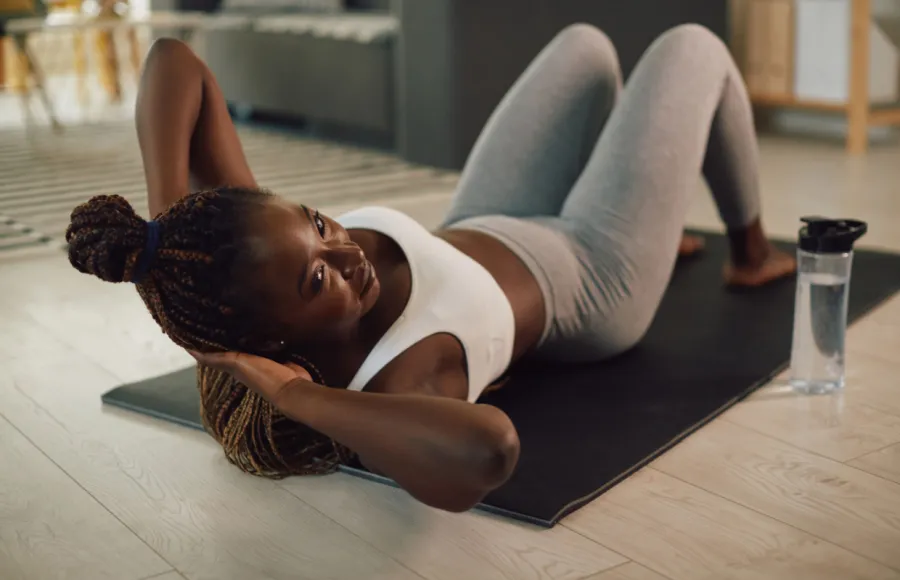No More Excuses- Let's get moving!

Starting and maintaining an exercise routine can be a challenge, but there are some simple strategies that can help. Firstly, remember that every bit of movement counts towards your weekly activity goals. Consider seeking guidance from a fitness app, small group training, or a personal trainer to help with this progression.
Whether it’s a short walk, a few flights of stairs, or a quick set of squats, it all adds up. Avoid the temptation to dive into an intense routine right away, as this can lead to burnout and potential injuries. Instead, start at a comfortable level and gradually increase intensity and duration over time.

Don’t limit exercise to formal workouts. Everyday activities like playing with your kids, cleaning, gardening, dancing, or even walking your dog contribute to your movement goals. Treat exercise like any other important appointment by scheduling it into your day. This helps establish it as a non-negotiable part of your routine.

Why should you exercise?
Having an active lifestyle plays an important role in achieving and sustaining a healthy body weight, building muscle mass, and lowering the risk of chronic illnesses. Studies have demonstrated on countless occasions that exercise has a positive impact on mental well-being, mood, and sleep quality, while also contributing to an improved sex life. Additionally, it is a key factor in maintaining high energy levels.
Stop thinking and start moving
Absolutely impressive, right? However, despite having all this valuable knowledge, you might still struggle with that urge to hit the snooze button for early morning workouts or choose the comfort of your couch if you prefer afternoon exercise. That’s where targeted and well-thought-out habit adjustments come into play. Tailoring your fitness routine to align with your personality, daily schedule, preferences, and aversions can be the game-changer that keeps you committed to your workout plans and prevents any unexpected set backs.
Which type of training is best for you?



Selecting a workout that genuinely excites you is key. Just because your friends rave about Calisthenics or CrossFit doesn’t mean those are best for you. Start by reflecting on what brings you joy — is it being in nature, the camaraderie of group settings, the thrill of sports, quiet introspection, or the satisfaction of a challenge? Its best to find activities that align with these preferences and personality.
Are you motivated by competition? If so, exercising with a friend who pushes you or joining a group fitness class could be beneficial. If you thrive on immediate feedback, workouts linked to progress-tracking apps or a fitness coach might be highly motivating for you. Remember, it’s about finding what resonates with you personally.
Note: Before diving into your workout routine, it’s advisable to undergo a health check-up to ensure you’re starting on the right foot. This can help identify any underlying health concerns and allow you to tailor your exercise plan accordingly. Once you have the green light, set realistic goals that align with your fitness level and aspirations.

To truly make exercise a lasting part of your life, integrate it into your daily routine. This can be as simple as designating a specific time for your workout each day or finding ways to incorporate movement into your regular activities.

Popular Types of Exercises
Aerobic: This involves continuous movement and is crucial for any fitness regimen. It includes activities like swimming, running, and dancing.
Strength: These exercises focus on building muscle power and strength. They involve activities like resistance training, plyometrics, weightlifting, and sprinting.
Calisthenics: These are bodyweight exercises performed without gym equipment. They engage large muscle groups and are done at a moderate aerobic pace. Examples include lunges, situps, pushups, and pullups.
High-Intensity Interval Training (HIIT): HIIT consists of short bursts of high-intensity exercise followed by periods of low-intensity exercise or rest.
Boot Camps: These are timed, high-intensity circuits that combine aerobic and resistance exercises.
Balance or Stability: These exercises aim to strengthen muscles and improve coordination. They include activities like Pilates, tai chi poses, and core-strengthening exercises.
Flexibility: These exercises aid in muscle recovery, maintain range of motion, and help prevent injuries. Examples include yoga and individual muscle-stretch movements.

Get Motivated
Get Inspired and Find What You Love: Understanding that humans naturally want to excel at activities, it’s important to seek out not only what brings pleasure, but also what aligns with your confidence and interests. Remember, the chosen activity may not always be effortless. While workouts should challenge your endurance or muscle-building capacity, they shouldn’t feel like a forced struggle.
For example, if you thrived in sports as a kid, joining an adult league in basketball or soccer can provide both confidence and fitness benefits. Similarly, if you’ve dreamt of acquiring a particular physical skill, like self-defense, embracing activities like kickboxing or jiu-jitsu can be both fulfilling and invigorating.



Tips to Stay Committed
Calendar Commitment: Treat your workouts like important appointments. Start with a gradual introduction to your routine. Avoid sudden, drastic changes. Allocate specific days for exercise on your calendar. Instead of a fixed number, aim for a flexible range of sessions per week, like three to five.
Short, Effective Bursts: If time is a challenge, break your workout into shorter, focused spurts. For instance, consider a few brisk 10-minute walks scattered throughout the day. Research shows this approach yields similar benefits to one longer, continuous session.
Set Mini-Goals: While big goals like losing a significant amount of weight or achieving a six-pack are motivating, they may not provide clear guidance for immediate action. To maintain motivation, prevent boredom, and ensure steady progress, establish smaller “process goals” that you can work on in the short term. These mini-milestones add up to significant achievements over time.
Morning VS Evening Workout Sessions


Morning Workouts
Why not work Out in the Morning and Get It Out of the Way? Some people find it easier to stick to their workout plans if they do it in the morning, getting it out of the way before an excuse comes up to skip it. By the end of the day, you’re often really tired, random things have come up, and there’s always something else to do instead of exercise.
On another note, morning workouts have been shown to lower blood pressure among older adults and people with overweight or obesity. People often admit that they feel more energized throughout the day after exercising, That means an early workout can actually help you tackle your responsibilities (like work or chores) with greater ease. At the end of the day it all depends on your schedule.
Evening Workouts
Working out at the end of your day offers a range of benefits. First, it taps into peak muscle performance. Late-afternoon and evening workouts align with hormone levels and body temperature fluctuations, enhancing strength gains. Moreover, a nighttime session allows focused, uninterrupted training without the usual gym crowds. You’ll discover increased endurance, up to 20 percent longer, and higher intensity for both cardio and strength training.
Surprisingly, late-night exercise promotes better sleep, helping you fall asleep faster and enjoy deeper rest. It’s a powerful stress-reliever too, releasing mood-boosting endorphins. Just make sure to workout at least three hours before your bed time to reduce cortisol levels that may affect your sleep. Although some persons say that its does not affect their sleep at all, its best to have a calm down routine that will help you relax after an intense evening workout session.

Remember, consistency is key, and progress may be gradual but is always worth the effort. Listen to your body, be patient with yourself, and celebrate every milestone, no matter how small. Surround yourself with positivity and seek support when needed. Most importantly, have fun and let your fitness journey be a source of joy and empowerment. Cheers to your new adventure in health and well-being! Keep moving forward!
Related articles:

Amazing Transformation: Beginner’s Luck

Walking: Slim down & Lose belly fat

Who needs Exercise?- The answer will surprise you

Losing Weight is too hard

Get Fit, Lose Weight & Eat Anything I want


